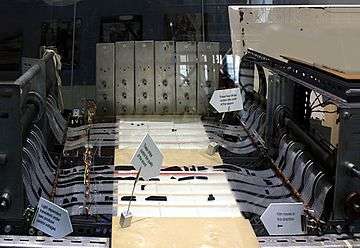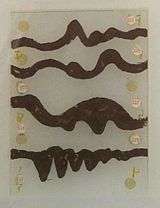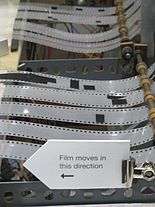Oramics

Oramics is a drawn sound technique designed in 1957 by musician Daphne Oram. The machine was further developed in 1962 after receiving a grant from the Gulbenkian Foundation. The technique, similar to Yevgeny Sholpo's "Variophone", involves drawing on 35mm film strips to control the sound produced.
Oram's composition machine consisted of a large rectangular metal frame, providing a table-like surface traversed by ten synchronised strips of clear, sprocketed 35mm film. The musician drew shapes on the film to create a mask, which modulated the light received by photocells. Although the output from the machine was monophonic, the sounds could be added to multitrack tapes to provide more texture.
The original machine was exhibited at the Science Museum in London between 2011 and 2015.[1][2]
The technique has similarities to that used by Scottish filmmaker Norman McLaren, some of whose films featured sounds created by drawing or printing various patterns, such as triangles and circles, along the optical soundtrack area of the film.
Oramics was also the name used by Oram to refer to her studio and business interests generally.
Gallery




Note: similarly, the amplitude control circuit should be exist on somewhere.
- Sound of Oramics (video)

See also
References
- ↑ "Daphne Oram's Oramics Machine to go on display", BBC News, 2011-04-04, retrieved 2011-05-29
- ↑ Oramics to Electronica: Revealing Histories of Electronic Music, Science Museum (London)
Further reading
- Daphne Oram (1972), An Individual Note: Of Music, Sound And Electronics, Galliard, ISBN 978-0-8524-9109-6
External links
| Wikimedia Commons has media related to Oramics. |
- "Oramics", daphneoram.org
- Daphne Oram Collection, Goldsmiths, University of London
- Hugh Davies (2003), Daphne Oram: a tribute to a pioneer, London: Sonic Arts Network, Archived from the original on February 10, 2006 (find archive)
- Daphne Oram and 'Oramics' (1959), 120years.net
- Video
- Nick Street (2011). Oramics (2009) [Nick Street's video] (video). — showing detail of the machine's internals (as is in 2009)
- Nick Street (2011). Oramics to Electronica (video).
- Aura Satz (2012), Oramics: Atlantis Anew (video)
- BBC News
- Giles Wilson (23 January 2003), "Daphne Oram, the unsung pioneer of techno", BBC News online
- "How Daphne Oram's Oramic machine changed electro music", BBC News Technology, 4 April 2011